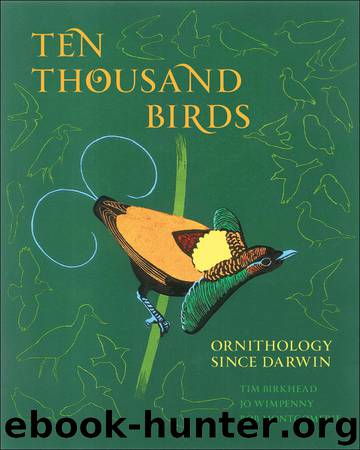Ten Thousand Birds by Birkhead Tim; Wimpenny Jo; Montgomerie Bob

Author:Birkhead, Tim; Wimpenny, Jo; Montgomerie, Bob [Birkhead, Tim, Wimpenny, Jo and Montgomerie, Bob]
Language: eng
Format: epub
Publisher: Princeton University Press
Published: 2014-08-28T16:00:00+00:00
Artist’s impression of the way Tinbergen and Lorenz conducted their hawk-goose model experiments with a pulley system that allowed them to fly hawk and other shapes over turkey poults. Inset (top) shows the range of shapes used in the experiments.
To test his ideas, in 1951 Lorenz took on Schleidt as an assistant to repeat the hawk-goose experiments. As well as using a hawk-goose dummy, Schleidt and his wife presented circular discs and rectangular shapes over the test birds. Young domestic fowl responded the same way to a plain black disc and the silhouette of a buzzard. Indeed, typical fear responses were elicited by any object, except that the birds habituated and stopped responding if the stimulus was presented repeatedly. Lorenz’s idea that slow speed was the key stimulus was also confirmed. Schleidt made minute rectangular dummies—just 7.5 millimeters (0.30 inches) in length—and when he flew these over the birds at various speeds, he found that the fear response occurred only when the dummies moved slowly (i.e., resembling high-flying predators). When flown quickly (more like insects), there was little response. Using hand-reared turkeys, Schleidt found that object novelty was the important feature eliciting the fear response. Collectively, these experiments led to the “selective habituation hypothesis,” which Lorenz welcomed. There was no support for Tinbergen’s short-neck hypothesis—but for several decades this remained the most common interpretation in animal behavior textbooks (Schleidt et al. 2011).
When the Second World War started in 1939, dialogue between Tinbergen and Lorenz came to an abrupt halt. Tinbergen, like many of his fellow Dutchmen, spent part of the war in prison—in his case, as a hostage for protesting against the expulsion of Jewish professors from Leiden University. Tinbergen was at his home doing bird work when he was taken captive in September 1942 and sent to a prison camp in southern Holland.57 Although relatively well treated, the constant threat of death in retaliation for Dutch resistance activities made incarceration stressful; on two occasions small groups of prisoners were taken out and shot. Despite his internment, Tinbergen was allowed to work as long as he did not use the English scientific literature. Even so, he wrote a draft of his now classic Social Behaviour in Animals, eventually published in 1953. He was released in September 1944.
In rather stark contrast, the jobless Lorenz opportunistically joined the Nazi Party in 193858 (Kalikow 1983). A public lecture on the behavior of domestic geese and crosses between domestic geese and Greylag Geese provided Lorenz an opportunity to show that his research had a bearing on the racial concerns of the Third Reich.59 Lorenz argued that humans suffered the same fate, thereby providing “evidence” for superior and inferior sectors of society. In October 1941 Lorenz was drafted into the German army. Captured by the Russians in 1944, he was held prisoner until 1948, long after the war had ended. Like Tinbergen, Lorenz continued to be productive both during the war60 and then in captivity, where he produced a manuscript on the comparative study of
Download
This site does not store any files on its server. We only index and link to content provided by other sites. Please contact the content providers to delete copyright contents if any and email us, we'll remove relevant links or contents immediately.
Sapiens: A Brief History of Humankind by Yuval Noah Harari(13993)
The Tidewater Tales by John Barth(12397)
Mastermind: How to Think Like Sherlock Holmes by Maria Konnikova(6938)
Do No Harm Stories of Life, Death and Brain Surgery by Henry Marsh(6689)
The Thirst by Nesbo Jo(6442)
Why We Sleep: Unlocking the Power of Sleep and Dreams by Matthew Walker(6362)
Life 3.0: Being Human in the Age of Artificial Intelligence by Tegmark Max(5193)
Sapiens by Yuval Noah Harari(5125)
The Longevity Diet by Valter Longo(4861)
The Body: A Guide for Occupants by Bill Bryson(4586)
The Rules Do Not Apply by Ariel Levy(4525)
The Immortal Life of Henrietta Lacks by Rebecca Skloot(4261)
Why We Sleep by Matthew Walker(4192)
Animal Frequency by Melissa Alvarez(4156)
Yoga Anatomy by Kaminoff Leslie(4106)
The Hacking of the American Mind by Robert H. Lustig(4090)
All Creatures Great and Small by James Herriot(3988)
Barron's AP Biology by Goldberg M.S. Deborah T(3946)
Double Down (Diary of a Wimpy Kid Book 11) by Jeff Kinney(3930)
